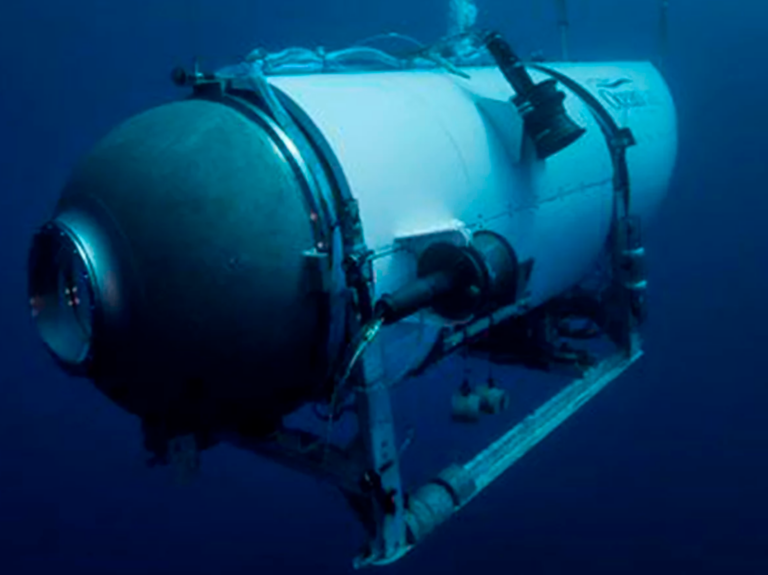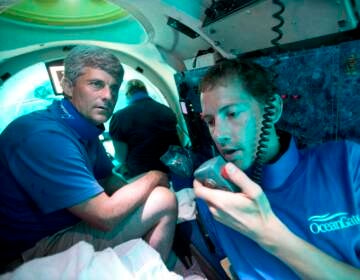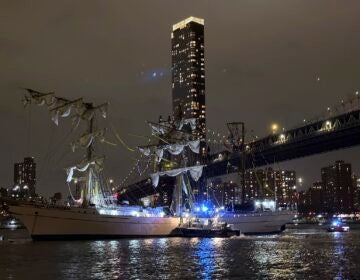The U.S. Coast Guard is bringing in new ships and underwater vessels to search for lost submersible
Coast Guard officials said underwater noises were detected by a surveillance aircraft and officials are searching an area twice the size of Connecticut.

This undated photo provided by OceanGate Expeditions in June 2021 shows the company's Titan submersible.
The U.S. Coast Guard said Wednesday that is bringing in new ships and underwater vessels to search for a submersible that vanished while bringing five people down to the wreck of the Titanic.
Coast Guard officials said underwater noises were detected by a surveillance aircraft and officials are searching an area twice the size of Connecticut.
The noises provided a measure of hope as search vessels working against long odds scoured the North Atlantic for the Titan, which vanished on Sunday.
But even those who expressed some optimism warned that many obstacles remain: from pinpointing the vessel’s location, to reaching it with rescue equipment, to bringing it to the surface — assuming it’s still intact — before the passengers’ oxygen supply runs out.
The area of the North Atlantic where the Titan submersible went missing on Sunday is prone to fog and stormy conditions, making it an extremely challenging environment to conduct a search-and-rescue mission, said Donald Murphy, an oceanographer who served as chief scientist of the Coast Guard’s International Ice Patrol.
After a Canadian military surveillance aircraft detected underwater noises in the search area, a robotic vessel was sent to scour the region but had so far “yielded negative results,” the Coast Guard wrote on Twitter.
The Coast Guard did not elaborate on what rescuers believed the noises could be. The vessel is estimated to have as little as a day’s worth of oxygen left if it is still functioning.
Three search vessels arrived on-scene Wednesday morning, including one that has side-scanning sonar capabilities. Authorities pushed to get salvage equipment to the scene in case the submersible is found.
The Coast Guard statement about detecting sounds underwater came after Rolling Stone reported that search teams heard “banging sounds in the area every 30 minutes.”
The report was encouraging to some experts because submarine crews unable to communicate with the surface are taught to bang on their submersible’s hull to be detected by sonar.
“It sends a message that you’re probably using military techniques to find me and this is how I’m saying it,” said Frank Owen, a submarine search and rescue expert. “So, that’s really encouraging if that’s the case.”
Richard Garriott de Cayeux, the president of The Explorers Club, wrote an open letter to his club’s adventurers, saying he had “much greater confidence” about the search after speaking to officials in Congress, the U.S. military and the White House.
However, no official has publicly suggested they know the source of the underwater noises.
Meanwhile, questions remain about how teams could reach the lost submersible, which could be as deep as about 12,500 feet (3,800 meters) below the surface near the watery tomb of the historic ocean liner. Newly uncovered allegations also suggest there had been significant warnings made about vessel safety during its development.
Lost aboard the vessel are pilot Stockton Rush, the CEO of the company leading the expedition. His passengers are a British adventurer, two members of a Pakistani business family and a Titanic expert.
Authorities reported the 22-foot carbon-fiber vessel overdue Sunday night, setting off the search in waters about 435 miles (700 kilometers) south of St. John’s.
The submersible had a four-day oxygen supply when it put to sea around 6 a.m. Sunday, according to David Concannon, an adviser to OceanGate Expeditions, which oversaw the mission.
Owen said the estimated 96-hour oxygen supply is a useful “target” for searchers, but is only based on a “nominal amount of consumption the average human might consume in doing certain things.” Owen said the diver on board the Titan would likely be advising passengers to “do anything to reduce your metabolic levels so that you can actually extend this 96 hours.”
Chris Brown, a British adventurer who paid a deposit to go on the Titan voyage but later withdrew because of what he called safety concerns, said word that the searchers have heard sounds is both good news and bad news.
“If the sounds are coming from below the water indicator then that indicates that they may be alive in the water, but now we’ve got time pressures in getting them up to the surface,” Brown told ABC’s “Good Morning America” Wednesday.
The submersible had seven backup systems to return to the surface, including sandbags and lead pipes that drop off and an inflatable balloon.
Aaron Newman, who has been a passenger on the Titan, told NBC’s “Today” show Wednesday that if the submersible is below a couple hundred meters and without power, the passengers are in complete darkness and it’s cold.
“It was cold when we were at the bottom,” he said. “You had layered up. You had wool hats on and were doing everything to stay warm at the bottom.”
Jeff Karson, a professor emeritus of earth and environmental sciences at Syracuse University, said the temperature is just above freezing, and the vessel is too deep for human divers to get to it. The best chance to reach the submersible could be to use a remotely operated robot on a fiber optic cable, he said.
“I am sure it is horrible down there,” Karson said. “It is like being in a snow cave and hypothermia is a real danger.”
Meanwhile, documents show that OceanGate had been warned there might be catastrophic safety problems posed by the way the experimental vessel was developed.
David Lochridge, OceanGate’s director of marine operations, said in a 2018 lawsuit that the company’s testing and certification was insufficient and would “subject passengers to potential extreme danger in an experimental submersible.”
The company insisted that Lochridge was “not an engineer and was not hired or asked to perform engineering services on the Titan.” The firm also says the vessel under development was a prototype, not the now-missing Titan.
The Marine Technology Society, which describes itself as “a professional group of ocean engineers, technologists, policy-makers, and educators,” also expressed concern that year in a letter to Rush, OceanGate’s chief executive. The society said it was critical that the company submit its prototype to tests overseen by an expert third party before launching in order to safeguard passengers. The New York Times first reported on those documents.
The search for the missing vessel has drawn international attention. In Dubai, where the missing British adventurer Hamish Harding lives, Crown Prince Hamadan bin Mohammed Al Maktoum wrote: “Dubai and its people pray for their safety and hopeful return home.”
Others aboard include Pakistani nationals Shahzada Dawood and his son Suleman, whose eponymous firm invests across the country. In Pakistan’s port city of Karachi, employees at his firms said they prayed for the two’s safe return, as did government officials. French explorer and Titanic expert Paul-Henry Nargeolet also was on the vessel.
Retired Navy Vice Admiral Robert Murrett, who is now deputy director of the Institute for Security Policy and Law at Syracuse University, said the disappearance of the submersible underscores the dangers associated with operating in deep water and the recreational exploration of the sea and space, “two environments where in recent past we’ve seen people operate in hazardous, potentially lethal environments,” Murrett said.
“I think some people believe that because modern technology is so good, that you can do things like this and not have accidents, but that’s just not the case,” he said.
___
Associated Press writers Jon Gambrell in Dubai, United Arab Emirates; and Munir Ahmed in Islamabad contributed to this report.
WHYY is your source for fact-based, in-depth journalism and information. As a nonprofit organization, we rely on financial support from readers like you. Please give today.





